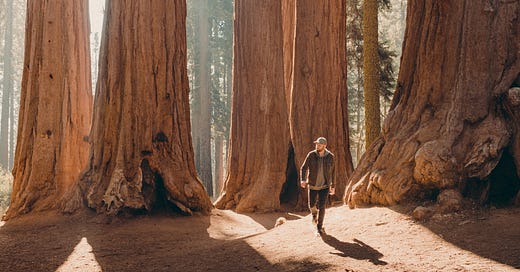Firefighters in California fight desperate battle to defend giant sequoias
Climate change threatens some of the most beautiful sights on our planet.
The changing climate changes the planet, including some of the most beautiful sights that you may see in your lives. From the magnificent glaciers in the mountains to the coral reefs in the oceans, we destroy some of the most iconic examples of nature. These late summer days of 2021, our attention turns briefly to the giant sequoia trees before another disaster will grab the world's attention within a few days.
I remember how amazed I was in the 1990s when seeing some of these enormous trees in California. Standing on the forest floor and looking up, they seemed to grow into infinity. And I remember my sadness when learning about the Castle Fire that killed some 10,000 giant sequoias last year. That number means that the world lost some 10% to 14% of all giant sequoias across the tree's natural range in the Sierra Nevada in just one year. You don't need to be a mathematician to see that losing such a percentage of trees that can grow thousands of years old is entirely unsustainable if these kinds of forest fires become a regular event.
Most of us make a mistake to treat these kinds of glacier-, coral-, or wildfire disasters that have the fingerprints of climate change all over them, as earthquakes: sad but unavoidable incidents. Unfortunately, these events are not incidents, and we could have avoided them. The structural change caused by the climate crisis, combined with the changes we made to the landscape that surrounds the trees, kills Sequoia's that can generally withstand forest fires. Our planet is getting hotter, and wildfires will likely worsen since warmer temperatures and drier climates allow the fires to grow more quickly and intensely.
When speaking about these disasters, this is usually when someone in the audience reminds me there have always been forest fires, often adding that the climate changed in the past. Unfortunately, although both of these statements are true, they give the wrong impression of business as usual.
In the past, some of the older sequoias that are still with us today have survived climate change, like the 'small ice age' of only a few hundred years ago. And the species has survived dramatic climate changes for much longer; the giant trees even survived the events that caused the extinction of the dinosaurs. However, the current speed of the change, the increased destructive forces, and the scale of the catastrophic events pose a completely new challenge for the species' survival. As a result, the IUCN lists giant sequoias as endangered species.
The landscape also changed since federal fire agencies suppressed as many fires as they could, thus allowing for dense vegetation to grow around the sequoias. Before the arrival of the first white settlers, the native population used to burn areas to cultivate food. The trees require periodic wildfires, sometimes caused by dry lightning, to clear competing vegetation. Without fire, shade-loving species will crowd out young sequoia seedlings, and sequoia seeds will not germinate.
The sequoias are not equipped to deal with these human-made changes in climate and landscape: the intensity of this century's wildfires is extreme because of the combination of ample fuel in the form of dense vegetation, higher temperatures, and dryer air. As a result, these robust trees that hardly ever died in forest fires are now endangered.
On Monday, firefighters battling the major KNP Complex wildfire in Sequoia National Park reported that the General Sherman Tree is still standing. It is the world's most giant tree, measured by volume; it stands 275 feet (83 m) tall, is over 36 feet (11 m) in diameter at the base, and is 2,500 years old. The firefighters were confident that they would be able to protect the Giant Forest with its thousands of giant sequoias.
But another wildfire, the Windy fire in Sequoia National Forest, is now threatening Long Meadow Grove, known for the Trail of Hundred Giants with 1,500-year-old sequoias. The fire did get into the top of at least one tree, which makes fighting it more complicated than on the forest floor. Two other groves in more remote areas, the Peyrone Grove and the Red Hill Grove, are entirely surrounded by wildfires.
Briefly, the General Sherman tree went viral on social media with pictures of the foil wrappings to protect it from wildfires. The tree may not have enjoyed its recent fame. I believe it prefers business as usual above a world where iconic natural monuments, from glaciers to giant trees, need to be wrapped up to survive the human-created new ecological conditions of the 21st century.
I write this newsletter because I believe that together we can do better on this beautiful but fragile planet.
This newsletter is and will remain an independent production. Accordingly, I have never accepted any advertising offers. I also aim to make as many editions as possible available for free.
Support from those who can afford it makes this independent newsletter available to all. You can join this initiative by taking a paid subscription.
Notes:
https://www.nps.gov/seki/learn/nature/sherman.htm
https://www.visualcapitalist.com/30-years-of-wildfires-in-america/
https://text.npr.org/1037914390
Photos:
Giant sequoias road: Photo by Mike Krejci from Pexels
Looking up: Photo by Nina Luong on Unsplash
Walking with giants: Photo by Dave Herring on Unsplash
Satelite image: European Union, Copernicus Sentinel-2 imagery
More reading:
What likely saved the General Sherman Tree from the KNP Complex Fire
https://www.sfgate.com/california-wildfires/article/KNP-Complex-General-Sherman-prescribed-burn-16473264.php











I have pitched a tent at the foot of a gracious Sequoia and slept in peace . . .
Thank you for writing about these glorious giants!! I had to opportunity to see these giants about 8 years ago. I was just in aww. The enormity of them is just breath taking. With climate change and all these fires, I worry that one day they'll be gone. Once again , thank you for writing about them.